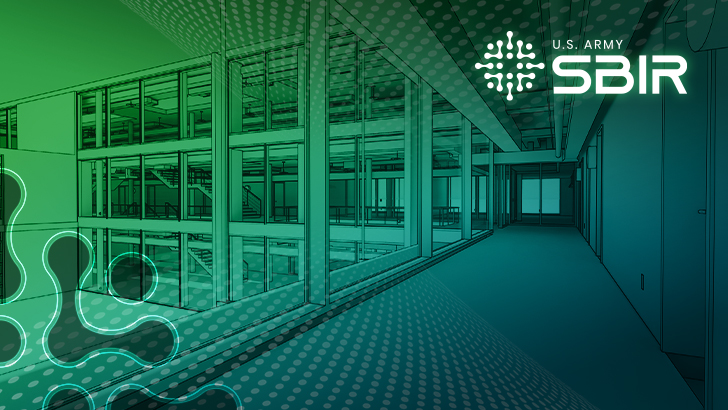

Objective
The proposed topic is a Direct-to-Phase-II effort to develop and integrate advanced building model generation capabilities into the Defense Threat Reduction Agency (DTRA) Edge-Enhanced Mapping and Positioning System (E2MAPS) program.
Description
Charged with supporting operations to counter weapons of mass destruction (WMDs), DTRA leads a broad range of R&D programs that support Army, SOCOM, and DoD stakeholders. DTRA research includes technologies fielded to support missions conducted in underground facilities (UGFs) and subterranean (SubT) environments, such as E2MAPS.
The E2MAPS program seeks the capability to perform real-time conversion of dense 3D point clouds to lightweight Building Information Models (Scan-to-BIM, collectively). Such a capability would benefit Army operators by enabling quicker identification of critical facility infrastructure, supporting mission planning, reducing cognitive load, and reducing network bandwidth. Existing capabilities to perform Scan-to-BIM in post-processing exist but cannot be applied to maps generated during fast-paced tactical operations. For this reason, DTRA is actively seeking the means to fund and integrate the proposed work.
Phase I
This is a Direct to Phase II. The technologies to enable DEEP-BIM currently exist but have not yet been collectively applied to enable real-time Scan-to-BIM capabilities at the edge. Building information models of large facilities are currently able to be generated with commercial software using reasonable computer resources and little human correction. Object recognition using imaging and LiDAR exists to support these capabilities as well as a host of other applications. Edge computing capabilities are widely available and applied in multiple forms with the E2MAPS program. The proposed DEEP-BIM project will integrate these technologies and enable them to be directly applied to subterranean counter-WMD operations performed by the Army, SOCOM, and other mission stakeholders
Phase II
This topic is a Direct-to-Phase-II. Expected Deliverables include, but are not limited to a ROS-based Scan-to-BIM software module, Phase III transition plan, and Technology roadmap outline:
Phase III
There is high dual-use potential for building information modeling. Investments in new construction are constantly being made in both the private and public sector. There are many opportunities for government programs and private firms to use this technology in their planning.
Submission Information
For more information, and to submit your full proposal package, visit the DSIP Portal.

References:
1. https://www.united-bim.com/ultimate-guide-of-scan-to-bim/
2. https://www.truepointscanning.com/using-3d-laser-scanning-for-facility-design-modifications
3. Wang, et al., Vision-assisted BIM reconstruction from 3D LiDAR point clouds for MEP scenes,
Automation in Construction, October 2021. https://doi.org/10.1016/j.autcon.2021.103997
4. Wallbaum, et al., Towards Real-Time Scan-Versus-BIM: Methods, Applications, and Challenges,
European Conference on Computing in Construction, July 2021.
http://dx.doi.org/10.35490/EC3.2021.17
Objective
The proposed topic is a Direct-to-Phase-II effort to develop and integrate advanced building model generation capabilities into the Defense Threat Reduction Agency (DTRA) Edge-Enhanced Mapping and Positioning System (E2MAPS) program.
Description
Charged with supporting operations to counter weapons of mass destruction (WMDs), DTRA leads a broad range of R&D programs that support Army, SOCOM, and DoD stakeholders. DTRA research includes technologies fielded to support missions conducted in underground facilities (UGFs) and subterranean (SubT) environments, such as E2MAPS.
The E2MAPS program seeks the capability to perform real-time conversion of dense 3D point clouds to lightweight Building Information Models (Scan-to-BIM, collectively). Such a capability would benefit Army operators by enabling quicker identification of critical facility infrastructure, supporting mission planning, reducing cognitive load, and reducing network bandwidth. Existing capabilities to perform Scan-to-BIM in post-processing exist but cannot be applied to maps generated during fast-paced tactical operations. For this reason, DTRA is actively seeking the means to fund and integrate the proposed work.
Phase I
This is a Direct to Phase II. The technologies to enable DEEP-BIM currently exist but have not yet been collectively applied to enable real-time Scan-to-BIM capabilities at the edge. Building information models of large facilities are currently able to be generated with commercial software using reasonable computer resources and little human correction. Object recognition using imaging and LiDAR exists to support these capabilities as well as a host of other applications. Edge computing capabilities are widely available and applied in multiple forms with the E2MAPS program. The proposed DEEP-BIM project will integrate these technologies and enable them to be directly applied to subterranean counter-WMD operations performed by the Army, SOCOM, and other mission stakeholders
Phase II
This topic is a Direct-to-Phase-II. Expected Deliverables include, but are not limited to a ROS-based Scan-to-BIM software module, Phase III transition plan, and Technology roadmap outline:
Phase III
There is high dual-use potential for building information modeling. Investments in new construction are constantly being made in both the private and public sector. There are many opportunities for government programs and private firms to use this technology in their planning.
Submission Information
For more information, and to submit your full proposal package, visit the DSIP Portal.
References:
1. https://www.united-bim.com/ultimate-guide-of-scan-to-bim/
2. https://www.truepointscanning.com/using-3d-laser-scanning-for-facility-design-modifications
3. Wang, et al., Vision-assisted BIM reconstruction from 3D LiDAR point clouds for MEP scenes,
Automation in Construction, October 2021. https://doi.org/10.1016/j.autcon.2021.103997
4. Wallbaum, et al., Towards Real-Time Scan-Versus-BIM: Methods, Applications, and Challenges,
European Conference on Computing in Construction, July 2021.
http://dx.doi.org/10.35490/EC3.2021.17
